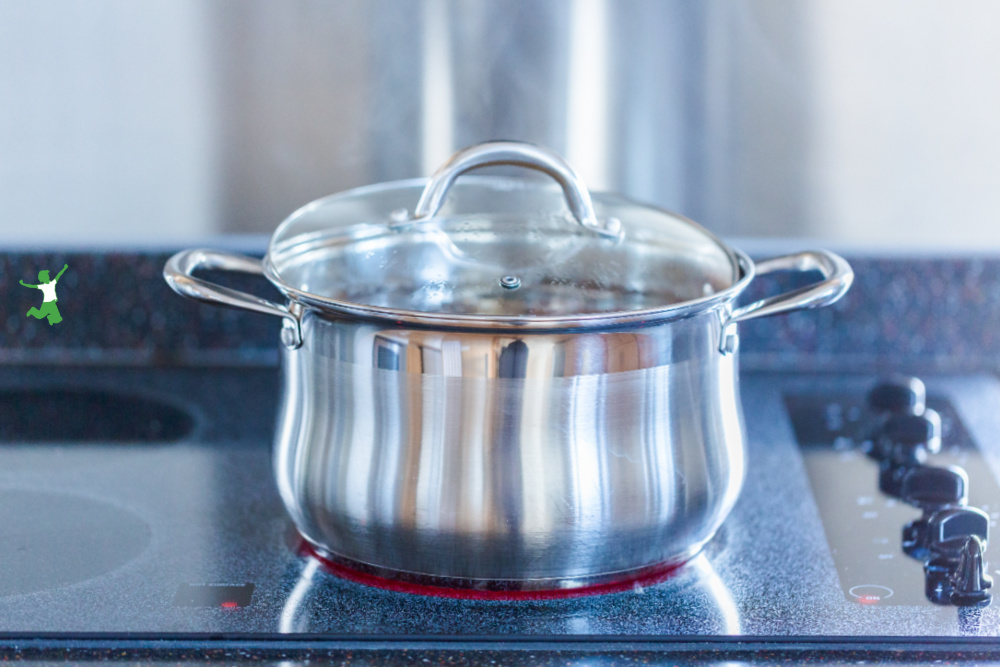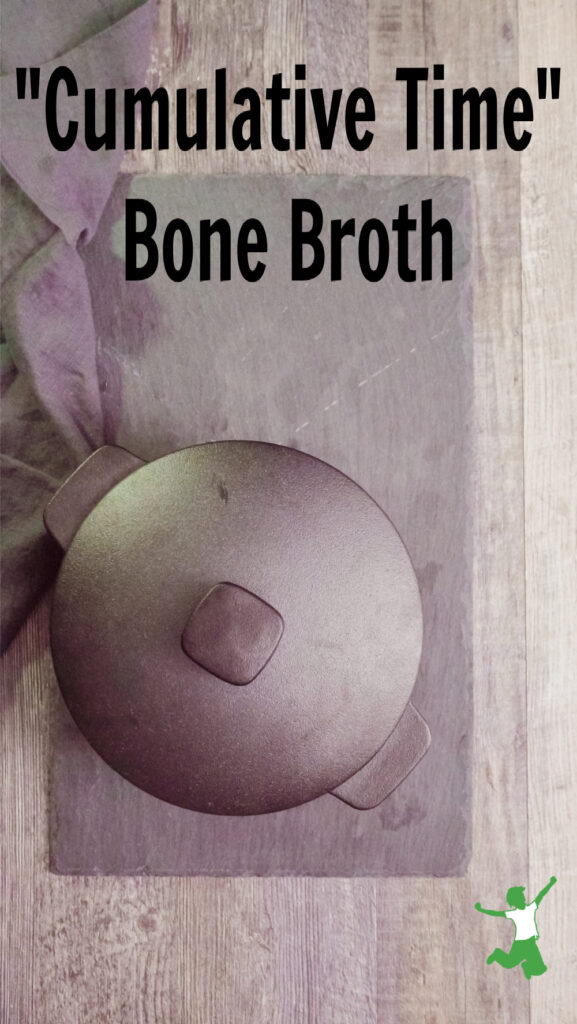Table of Contents[Hide][Show]
How to follow the “cumulative time” method for making bone broth, a strategy that does not involve leaving a simmering pot on the stove overnight or unattended while you are out of the house.

A big concern people have when they start learning how to make bone broth at home is about leaving a simmering stockpot on the stove for many hours.
Depending on when you start the process, this could entail leaving the pot simmering overnight or while you are out of the house temporarily.
This can be an unacceptable fire risk, so what to do in those situations?
While successfully producing a gelatinous pot of broth is critical, it should not involve a safety hazard to accomplish!
Fortunately, there are several options for avoiding this problem.
First of all, you can make meat stock or fish head broth. Both of these require only a couple of hours at the most to make.
If you are so time-crunched that you need something even quicker than that, I suggest bonito broth. This type of stock only requires the time necessary to boil a pot of filtered water.
Cumulative Time Bone Broth
At some point, however, you are going to need to make a proper pot of chicken or beef stock.
This type of long-simmering broth will require significantly longer than a couple of hours on the stove or in a slow cooker like a Vita-Clay.
In that situation, the cumulative time method is recommended. This is the approach suggested by Monica Corrado, CNC CGP of Simply Being Well.
She introduced me to this concept at a traditional health conference in Baltimore.
Monica really knows ancestral cooking like few others I’ve ever met. In addition to being a chef, she’s also a GAPS Practitioner. She has significantly helped my husband with his GAPS Diet journey…which requires a lot of properly made bone broth.
According to Monica, the cumulative time approach for making bone broth simply means that the required simmering time for a particular type of stock can either be continuous or broken up into sections that equal the total required duration when added together.
The catch is that each time you start to heat the broth again, you must bring it to a boil, skim the foam, and then lower the heat back down to a simmer.
Avoid the temptation of simply bringing the pot back to a quick simmer.
You must bring it to a boil first, skim and then reduce the heat to a simmer with the lid on. In other words, just repeat what you did at the beginning of the process.
What to Do When the Heat is Turned Off
There is no need to move the stockpot in and out of the refrigerator between simmering sessions on the stove.
This is because the pot stays very hot for hours after the heat is turned off.
For pathogens to start to grow, the stockpot would need to be at room temperature for 4+ hours.
Anyone who is experienced in making stock knows that a stockpot with the lid on will stay hot for many hours. It won’t get to room temperature for 4+ hours for at least half a day!
In my experience, the pot also will not get to room temperature if you turn off the heat and leave it on the stove overnight.
If the length of time to make bone broth had you concerned in the past, try the cumulative time approach!
An easy way to keep track is to keep a little notebook in the kitchen. Then, you can log the total amount of time the stock has simmered. This will ensure quality, gelatin-rich broth when you are finished.
Making stock safely couldn’t be easier when using the cumulative time method!








I use my crock pot for bone broth too, I unplug it in the morning when I leave for work. I put a couple cups and a bit of sea salt in a thermos to drink on my drive to work. Then when I get home I plug the crock pot in, bring it to a rolling boil, and then turn it down to a simmer while I’m sleeping. I repeat this each week, with a new batch. I guess I’m more scared to have the crockpot going when I’m not home, than to have it on when I’m sleeping 🙂
If I do have to leave it turned off at any time, I put a lid on it and bring it to a good rolling boil for a couple minutes before I shut it off. This should kill any pathogens that have happened to drift in and the lid keeps others from drifting in.
However, most of the time I just leave it simmering the entire time.
Ever whipped up a gelatinous stock in a VitaMix – FROTHY!!!!
I always use my crockpot. The rolling simmer is always perfect and my stock gels, no problem…even the lower quality chicken that I use sometimes to stay within budget.
I always make my stock in a crockpot. That way I feel comfortable leaving it going while I’m gone or overnight.
This is how I make bone broth. The broth is always wonderful. There’s never too much for freezing though. It’s usually gone within 3 days.
I do both the stove top and the crockpot. Although now with GAPS its both crockpots PLUS the stove top! lol! I do have to check the stove top though as its in a drafty place and has blown out before when someone left the back door open. That made me nervous so I try to use the crock. Is there anything wrong this using a crockpot? I bring it to a boil on the stove and then transfer it to the crock… and when reusing bones do you need to boil it again?
Since I work outside of the home, I am unable to use the stovetop (also have gas stove and worry about gas leak if flame went out) and need to start doing this regularly. I just started making my own broth and am so excited to add it to my family’s regimen. Could you please tell me how long you let your broth cook in the crockpot? I like the idea of boiling it and transferring! I am loving all these tips–and thanks to Sarah for getting this info out there for me!!
I have a gas stove as well and I can’t take that risk. I boil on the stove and then transfer to a crockpot. I wish mine had a temperature setting. That would be awesome!
I usually just boil it on the stove and get out the scum and then transfer it to my crock pot. I had to play around with the temp settings as I have two VERY different crocks and neither are anything fancy! I got it to where its def on the verge or at a low simmering bubble. (not boiling!) And honestly I leave it in the pot for however long it takes me to get back to it! lol! usually overnight. I would consider the timing the same as if you had it on the stove. I think the newer crocks that are all fancy would work even greater… thats why I am bugging my hubby to get me one 😉
I have always let mine simmer on extremely low heat overnight. Now I am wondering if I should be concerned doing that due to a fire hazard? :/
I’ve been doing this for years now. It’s nice to know that others are too.
We use a crock pot-works great and greatly lessens the risk of a fire.
What a great idea, Dawn. The thing that’s held me back from stock is definitely the time component. I’m not comfortable with an open flame going while we’re asleep or out, nor do I possess the planning & managing chops to keep track of simmering time. So I love the idea of the crock pot.
Can you share what kind you have, what temps you use, when you lower the temp, etc? I’m very new with the crock pot and only know enough to be dangerous – but not effective. ; )
I use my crockpot too. After letting the bones soak with a splash of ACV I turn it on high. Skim if needed once simmering. Later I will turn it to low for the rest of the time.
I definitely love my crockpot for stock making. I have a 6 quart hamilton beach that is about 5 years old. I add all the ingredients and a generous blast of vinegar, cover and cook on high. On high I get a nice simmer, and from beef bones I get stock with so much gelatin you have to gouge it from the jar. For chicken stock I get a much softer gel, but still it normally gels. If it isn’t gelled after 24 hours in the fridge (which happens if I don’t have many or very good quality bones in the pot), I put it back in the crockpot on high, bring it to a simmer and then I crack the lid. I let it cook ’til the volume is reduced by half. By then I normally have a nice gel.
Haha the first thing I thought when reading this was, USE YOUR CROCKPOT!!! Scrolled down to post and you had beaten me to the punch. 🙂 I don’t know if stock would ever get made at my house if not for a crockpot. We’re busy people and are in and out of the house all the time.
Once you’ve brought it to a boil and skimmed the scum, it’s best to turn it down so it is barely burbling. A high simmer for the duration isn’t recommended since it can oxidize the cholesterol, from what I understand. Ideally you want a very slow, almost still, gentle simmer.
I do the same thing. I turn it on high and let it boil for a couple hours then turn it on low for 24-48 depending on how much stock I’m making. It gels great every time!